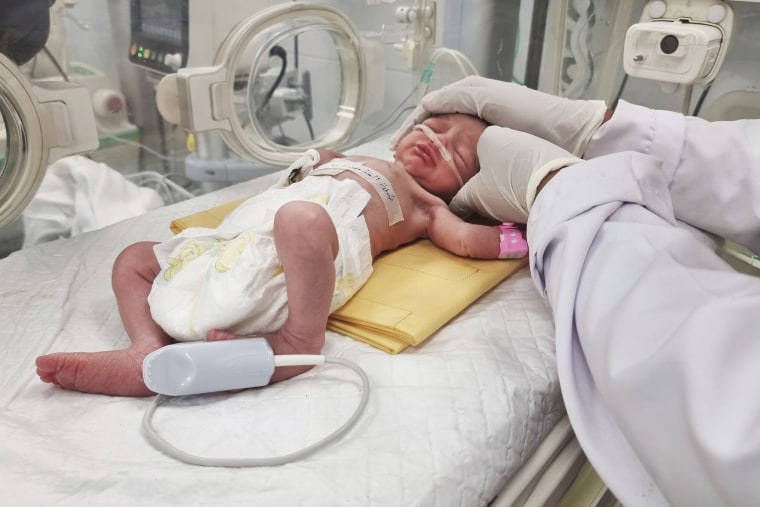NBC News found that Rafah’s Tal Al Sultan neighborhood, which was designated safe in leaflets dropped by the IDF on Dec. 18, was targeted less than a month later, on Jan. 9. Relatives said that 15 people died in a strike on the Nofal family home.
“Many of my cousins were killed,” one of the survivors, Ahmed Younis, told an NBC News crew in the immediate aftermath of the attack. Younis added that he had moved to the house believing it was safe “but there is no safe area. The house fell on our heads.”
A little over a month later, on Feb. 12, a strike hit the Al Shaboura refugee camp, which had also been listed as a safe zone on an IDF leaflet. An NBC News crew filmed dozens of dead bodies, some women and children, in the aftermath of the strike, one of several in Rafah that night.
A building in Al Shaboura was also leveled by an air attack on April 20. Among the dead was Sabreen Sakani — who was 30 weeks pregnant at the time. Her baby, Sabreen Alrouh Joudeh, was born an orphan after doctors were able to perform a posthumous cesarean section and rescue her from her mother’s lifeless body.
NBC News’ cameras captured the moment doctors revived the newborn. Her short life ended Thursday when she died after struggling with respiratory problems.

Areas that senior Israeli officials publicly stated were safe were bombed as well. On Nov. 4, Israeli Defense Minister Yoav Gallant told a news briefing in Tel Aviv that there would be no attacks on Al-Mawasi, a narrow strip of beachside land in the city of Khan Younis, promising that “anyone will be in a safe place” in that location. After Jan. 1, the IDF advised people on X to evacuate to Al-Mawasi 11 times.
But Israeli forces repeatedly launched strikes on the area. On Jan. 4, 14 people died, among them three children who perished when their tent was hit by a strike, Palestinian officials said. Footage taken by an NBC News crew less than an hour later showed a large crater.
“If Al-Mawasi is not safe, where should we go? No one is protecting us,” said Kamal Saleh, who witnessed the strike that killed 14 people in total.
NBC News sent the IDF the GPS coordinates for the seven strikes it identified in safe zones. The IDF replied in an email that it was “not aware of any strike at the provided coordinates and times,” for a March 26 strike on the Tal Al Zuhur neighborhood. It did not respond when asked about the six additional coordinates.
The IDF also blamed Hamas for telling people to ignore its directives to move. It said in a follow-up email that it would “act against Hamas wherever it operates, with full commitment to international law, while distinguishing between terrorists and civilians.”
Bashi, of Human Rights Watch, said that Palestinians have tried to follow the Israeli instructions. “People evacuate, people use the roads they were told to use, they go to the place they were told to go and then they get hit by an airstrike or by a ground force invasion,” she said.
“There is nowhere safe in Gaza,” she added.






